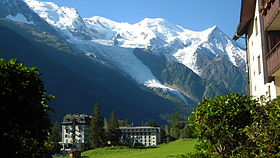Mont Blanc massif
| Mont Blanc massif | |
|---|---|

View from Chamonix on the French side of the Mont Blanc massif (left to right: Mont Maudit, Mont Blanc, Dôme du Goûter, Aiguille du Goûter plus the Bossons Glacier)
|
|
| Highest point | |
| Peak | Mont Blanc (Italian: Monte Bianco) |
| Elevation | 4,808.73 metres (15,776.7 ft) |
| Coordinates | 45°50′01″N 06°51′54″E / 45.83361°N 6.86500°ECoordinates: 45°50′01″N 06°51′54″E / 45.83361°N 6.86500°E |
| Dimensions | |
| Length | 46 km (29 mi) |
| Width | 20 km (12 mi) |
| Geography | |
|
Location in the Alps
|
|
| Countries | France, Italy and Switzerland |
| Parent range | Alps |
The Mont Blanc massif (French: Massif du Mont-Blanc; Italian: Massiccio del Monte Bianco) is a mountain range in the Alps, located mostly in France and Italy, but also straddling Switzerland at its northeastern end. It contains eleven major independent summits, each over 4,000 metres (13,123 ft) in height, and is named after Mont Blanc (4,808 metres (15,774 ft)), the highest point in western Europe. Because of its considerable overall altitude, a large proportion of the massif is covered by glaciers, which include the Mer de Glace and the Miage Glacier – the longest glaciers in France and Italy, respectively.
Not only does the massif form a watershed between the vast catchments of the Rhône and Po rivers, as well as a tripoint between France, Italy and Switzerland, it also marks the border between two climate regions by separating the northern and western Alps from the southern Alps. The mountains of the massif consist mostly of granite and gneiss rocks, and at high altitudes the vegetation is an arctic-alpine flora.
The valleys that delimit the massif were used as communication routes by the Romans until they left around the 5th century AD. The region has remained of some military importance through to the mid-20th century. A peasant farming economy operated within these valleys for many centuries until the glaciers and mountains were discovered by the outside world in the 18th century. Word of these impressive sights began to spread, and Mont Blanc was finally climbed in 1786, marking the start of the sport of mountaineering. The region is now a major tourist destination, drawing in over six million visitors per year. It provides a wide range of opportunities for outdoor recreation and activities such as sight-seeing, hiking, rock climbing, mountaineering and skiing. Around one hundred people a year die across its mountains and, occasionally, bodies have been lost and entombed in its glaciers for decades.
...
Wikipedia

